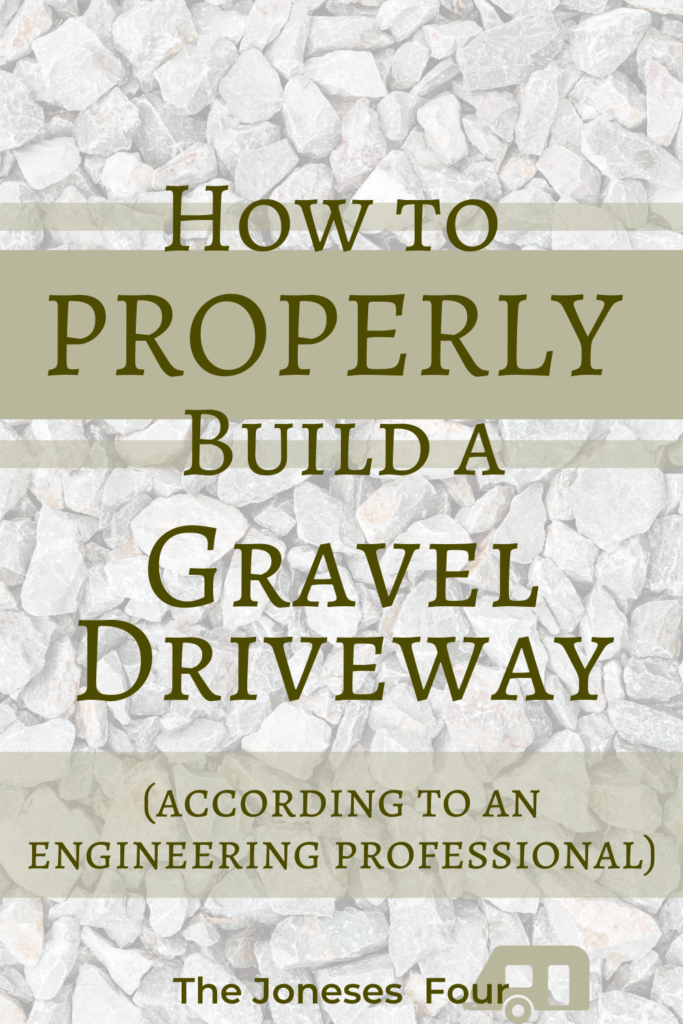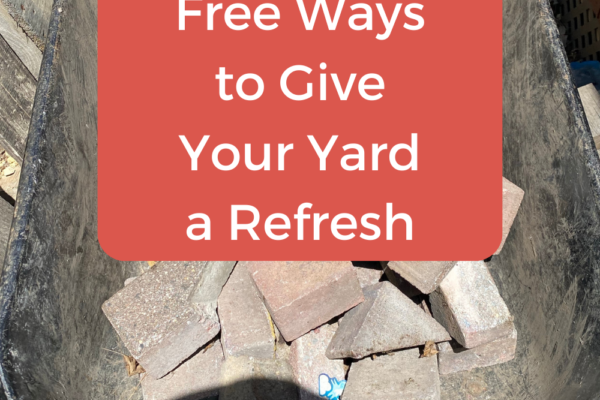This spring, we have the pleasure of building ourselves a gravel driveway. Okay, maybe pleasure is an exaggeration. But we need a place to keep our new-to-us camper project, and that place needs to be
a) free of undergrowth,
b) level, and
c) a place that won’t sink into the mud every spring.
We’ve built many level surfaces in our landscape over our years of homeownership and I feel pretty safe in saying that we might be experts. (It also doesn’t hurt that Ryan works in civil engineering, so he’s familiar with the makings of a good parking pad.)
Parking pads and DIY driveways are often an underestimated project. So many are haphazardly put together – sometimes just a few bags of rock thrown on a somewhat level part of the yard.
That is not the way to do it.

As a homeowner, I want my projects done well and properly. I know that a haphazardly constructed project is probably going to need to be redone in a few years’ time, so it’s best to do it right the first time. I also know that a project that’s done well can add value to your home and is sure to keep your neighbors happy. Our neighbors may not want to look at a trailer, but if it’s housed properly, they’re less likely to complain.
If you’re a renter and willing to do the project properly, discuss sharing costs with your landlord. An additional parking space will certainly add value. Off street parking can be hard to come by the rental community, and if they’re able to offer it to future tenants, it could mean additional income.
The principles of constructing a gravel pad are transferable to many projects with just a few tweaks. Even if you’re not looking to construct a gravel pad specifically, you may find the data here helpful if you’re doing any of the following:
- Building a paver patio
- Creating a base for a concrete pad
- Making a fire pit
- Constructing a retaining wall
Planning
Before you start digging, you’ll want to make sure that you know what you’re working with and gather your supplies. But first, do a few things:
- Most importantly, be sure that you know where your utility lines come in. Here’s a link to Diggers Hotline. Set up an appointment and they will mark your utilities within a few days.
- Check to see if you need a building permit. No one wants to build something only to deconstruct and rebuild it over some paperwork.
- Think about and observe where the water flows. You never want water running toward your house. If there are any pooling issues or if you’ll be blocking an outflow, consider a drain tile.
Soil
We live in western Wisconsin and our terrain is largely sand under the topsoil. This makes creating a level surface that will last a little easier. Many surrounding communities, however, have clay. If you’re working in a clay area, use a layer of heavy landscaping fabric between the earth and the gravel. This will keep the rocks from being individually suctioned in and your work from slowly sinking.
Border
If the area you’re working within isn’t level (our side yard is not), you’ll want to factor in some kinds of retaining structure. Cinder blocks are a cheap option; retaining wall blocks work well and can fit any aesthetic; timber costs are on the rise, but that’s an option, too. Working with 4x4s or wood panels will also require additional construction, which we won’t be covering here. For our project, we’re opting to use railroad ties. We’ve been talking about using railroad ties in a yard project for a long time, and the time has finally come about. Railroad ties are a great option for us
for this project. It’s an upcycled product so it’s not contributing to deforestation and they’re less expensive than new wood.
Note: Railroad ties are NOT a great option for a lot of projects. Railroad ties are treated with creosote which, per the EPA, poses risks for fish and invertebrates. As such, it would not have been a good option for our raised beds or the rain gardens in our pollinator-friendly yard.
Measure
How much space do you need? In our case, our trailer is 6’x12’ excluding the hitch and wedge. To provide a couple of feet of wiggle room for parking, our final space will be 10’x14’.
You’ll also need to know how much space you need to fill. In our case, we’re planning to use 8” of gravel. This may seem like a lot, but we want to make sure our base is solid. We do not recommend using less than 6”.
Additionally, we’re not just making a gravel pad, but a driveway addition, so we’ll need to calculate the extra area for the ramp space.
We frequently order our rock from a local excavator. We have a utility trailer to pick up, but for large loads, it’s much easier to just have them deliver.
We like going to our local excavator v. a big box store for bags for a number of reasons:
- It’s local. This not only supports the local entrepreneurs and economy, but if your dirt has any bugs, they’re local, too.
- They can deliver! This will save you time and an aching back. Picking up product at the store and dragging it all home takes time and effort. In this particular project, if our hole is dug out before they arrive, they can dump the gravel right where it needs to be. Big win!
- It saves all that plastic from being used. Buying dirt, rock, and gravel by the ⅓ cubic foot uses a LOT of plastic. In order to recycle it, it would need to be rinsed out, dried, and taken to a store that does plastic recycling (and it’s still not guaranteed). In a project this size, that is the last thing I want to be doing at the end of the day.
(Note: If you just want just a little of a certain material, you can bring five gallon buckets to your excavator. I’m sure they won’t have any problem working with you. We’ve done this on several occasions for sand and pea gravel.)
Calculate your gravel yardage
But first you need to know how many yards to order. The equation to measure yards of material needed (cubic yardage) is (volume in cubic feet)/27:
Rectangle: (L x W x H)/27
Triangle: (0.5 x base x height)/27 (or you can figure the area of a second rectangle and half it)
The height of a triangle in this case can easily be measured where the pad meets the existing driveway to the outside of the pad.
The base would be the length along the driveway.
In our case:
(10’ x 14’ x (8/12*))/27=cubic yardage
*The 8/12 is because we plan to use 8” of gravel.
Still confused? Check out this page on cuemath.com.
Measure and dig
Grab your tape measure and your long level and let the fun begin! Measure off the space you need to dig and mark it with some spray paint. Why dig? If you want a level finished product (and you do want a level finished product*), you need a level base. You’ll also need to make sure that the ground on which you lay your border is level, too. As I previously stated, our side yard is not level, so for this project, we have a fair amount of work to do.
Digging wheelbarrow after wheelbarrow of earth isn’t a lot of fun. If you have the means, rent a skid steer to dig. If not, put on your most comfortable yard gloves and adopt a positive attitude.
(*While you want your final product to be level, it should maintain a slight (2-3%) grade sloping away from your house. Basically this means that the bubble on your level should still be in the middle, but tip up ever so slightly toward your house.)
Digging tips:
- Figure out where you’ll be putting your dirt before you start. (Wanna build a raised bed? Fill a low space? Make a mound in your yard?)
- Always point your empty wheelbarrow in the direction you’ll be heading once it’s full.
- Don’t overfill your wheelbarrow or you’ll be kicking yourself when it tips.
- Remove any rings before digging. Your fingers may swell over the course of the day making them uncomfortable or worse.
- Always wear yard gloves.
Start at the edge and work your way around, measuring down. If the space you’re working in is unlevel, use a long level and a tape measure to calculate how far down you need to dig from the high points.
As you dig, occasionally check to make sure your ground is level in every direction.
After you’ve finished digging, rake it out and tamp it down. If you have access to a plate compactor, this is a great time to use it! If not, a manual one will do just fine.
Add the retainer
If you’re including something to retain the pad, now is the time to install. If not, it’s time to start shoveling gravel!
After your gravel is placed, tamp it down one more time.
At this point, you can call it a day or you can look at adding another landscaping material on top.
Top rock
For this project, we opted to use a grey trap rock on top. We like its aesthetic better than plain gravel and it’ll help reduce the gravel’s erosion over time. If you’re curious about other options, talk to your local excavator. I’m sure that they’d be willing to help find a good solution for you.
After all this is laid, it’s time to park our trailer and crack a cold one.
What project are you working on? We’d love to hear about it in the comments below!
Cheers!
– The Joneses Four





3 thoughts on “How to Properly Build a Gravel Driveway”